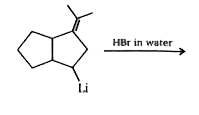Which of the following are true for an acid- base titration?
Indicators catalyse the acid-base reactions by releasing or accepting H⊕ ions.
Indicators do not significantly affect the pH of the solution to which they are added
Acid-base reactions do not occur in the absence of indicators
Indicators have different colours in dissociated and undissociated forms.
The correct Answer is:B, D
To determine which statements are true for an acid-base titration, we will analyze each statement provided in the question.
1. Statement Analysis:
- We have four statements to evaluate. Let's analyze each one.
2. Statement 1: "Indicators catalyze the acid-base reaction by releasing or accepting H⁺ ions."
- Analysis: This statement is incorrect. Indicators do not catalyze the reaction; rather, they are substances that change color in response to the pH of the solution. They do not participate in the acid-base reaction by releasing or accepting H⁺ ions.
3. Statement 2: "Indicators do not significantly affect the pH."
- Analysis: This statement is correct. Indicators are typically weak acids or bases and do not significantly alter the pH of the solution when added in small amounts. Their primary role is to indicate the pH level through color change.
4. Statement 3: "Acid-base reactions do not occur in the absence of indicators."
- Analysis: This statement is incorrect. Acid-base reactions can occur without the presence of indicators. Indicators are merely used to observe the endpoint of the titration but are not necessary for the reaction to take place.
5. Statement 4: "Indicators have different colors in dissociated and undissociated forms."
- Analysis: This statement is correct. Many indicators exhibit different colors depending on whether they are in their dissociated (ionized) or undissociated (neutral) forms. For example, phenolphthalein is colorless in acidic solutions and pink in basic solutions.
6. Conclusion:
- The correct statements regarding acid-base titration are:
- Indicators do not significantly affect the pH.
- Indicators have different colors in dissociated and undissociated forms.
Summary of True Statements:
- True Statements:
- Indicators do not significantly affect the pH.
- Indicators have different colors in dissociated and undissociated forms.
- We have four statements to evaluate. Let's analyze each one.
- Analysis: This statement is incorrect. Indicators do not catalyze the reaction; rather, they are substances that change color in response to the pH of the solution. They do not participate in the acid-base reaction by releasing or accepting H⁺ ions.
- Analysis: This statement is correct. Indicators are typically weak acids or bases and do not significantly alter the pH of the solution when added in small amounts. Their primary role is to indicate the pH level through color change.
- Analysis: This statement is incorrect. Acid-base reactions can occur without the presence of indicators. Indicators are merely used to observe the endpoint of the titration but are not necessary for the reaction to take place.
- Analysis: This statement is correct. Many indicators exhibit different colors depending on whether they are in their dissociated (ionized) or undissociated (neutral) forms. For example, phenolphthalein is colorless in acidic solutions and pink in basic solutions.
- The correct statements regarding acid-base titration are:
- Indicators do not significantly affect the pH.
- Indicators have different colors in dissociated and undissociated forms.
- True Statements:
- Indicators do not significantly affect the pH.
- Indicators have different colors in dissociated and undissociated forms.
Topper's Solved these Questions
- IONIC EQUILIBRIUMBOOK - CENGAGE CHEMISTRY ENGLISHCHAPTER - IONIC EQUILIBRIUMEXERCISE - Exercises Single Correct
121 Videos
- IONIC EQUILIBRIUMBOOK - CENGAGE CHEMISTRY ENGLISHCHAPTER - IONIC EQUILIBRIUMEXERCISE - Exercises Assertion-Reasoning
36 Videos
- IONIC EQUILIBRIUMBOOK - CENGAGE CHEMISTRY ENGLISHCHAPTER - IONIC EQUILIBRIUMEXERCISE - Exercises Linked Comprehension
45 Videos
- HYDROGEN, WATER AND HYDROGEN PEROXIDEBOOK - CENGAGE CHEMISTRY ENGLISHCHAPTER - HYDROGEN, WATER AND HYDROGEN PEROXIDEEXERCISE - Subjective Archive (Subjective)
3 Videos
- ISOMERISMBOOK - CENGAGE CHEMISTRY ENGLISHCHAPTER - ISOMERISMEXERCISE - Assertion-Reasoning Type
1 Videos
Similar Questions
Knowledge Check
In Which of the following reaction an acid-base reaction takes place ?
A B
B C
C DAll of these
DAll of these
Which of the following statement is true for acids?
View SolutionWhich of the following are conjugate acid-base pairs ?
View SolutionWhich of the following species can be formed in acid-base reactions as Bronsted base as well as Bronsted acids?
View SolutionWhich of the following do not form conjugate acid - base pair in the right order :-
View SolutionWhich of the following is a conjugated acid - base pair?
View SolutionAcetic acid is titrated with NaOH solution. Which of the following statement is correct for this titration?
View SolutionWhich of the following is not true for maleic acid and fumaric acids?
View Solution
